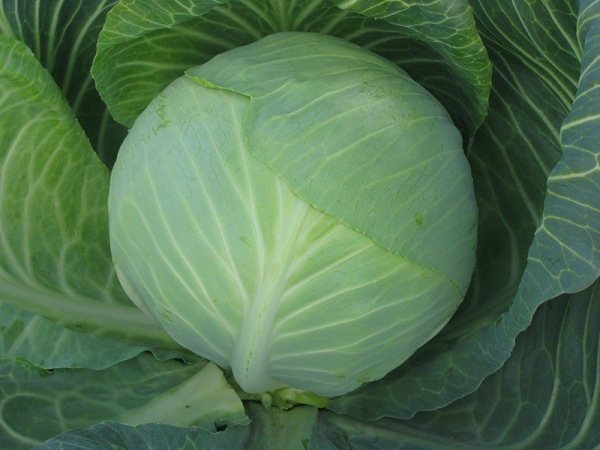Growing cabbage carries too many subtleties, so for a long time you just don’t know if the effort can lead to a good harvest. But with a variety like Valentina F1 there are almost no misfires, and the result can be seen long before the harvest. This variety of late ripening cabbage is a hybrid and has already rightfully gained a well-deserved popularity among gardeners. The description and characteristics of this variety can be found below.
Table of contents
Description and characteristics of the variety of cabbage Valentina
The cabbage Valentina F1 was bred at the N. N. Timiryazev Breeding Station, by the breeders A. V. Kryuchkov, G. F. Monakhos, and D. V. Patsuria. Already the first tests of this hybrid confirmed the high productivity of the variety. and its suitability for cultivation in various climatic zones.
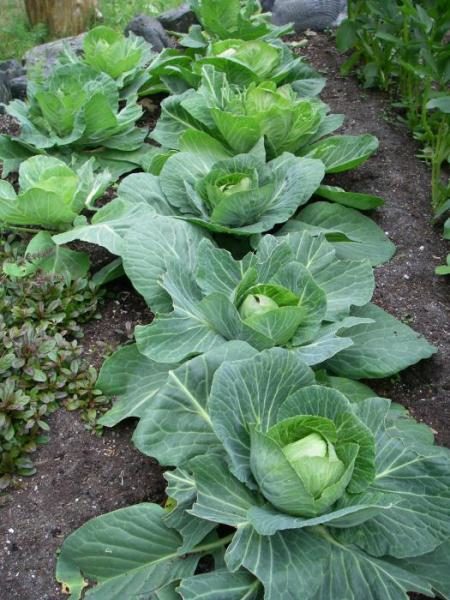
From the shoots of the shoots to the maturation of the Valentine F1 hybrid, 140-180 days pass, and it can be grown both in open ground and in the greenhouse. A head of cabbage has a flat oval shape, rather dense, weighing 3-5 kg. Outside it is covered with dark green leaves that have a bluish wax coating, which is a varietal feature of the Valentine's hybrid. On the cut forks has a white color.
Valentina F1 ripens to steady frosts and easily tolerates short-term freezing during a sudden cold snap, which does not affect further storage. If adult plants easily tolerate frosts down to -5 -8 C °, then seedlings - up to -3 C °.
Initially, cabbage has a slight bitterness taste, which completely disappears during storage.Therefore, it is recommended to use this hybrid in food not earlier than 3 months after harvesting. During this period, the forks will become tender, juicy and sweet, without coarse streaks.
Like any other plant, the Valentine F1 variety has its advantages and disadvantages.
The advantages include:
- the good frost resistance;
- high yield;
- long shelf lifeduring which the taste of the heads only improves;
- fruit resistant to cracking;
- heads of cabbages good carry transportation;
- resistance to many diseasesincluding fusarium;
- good stability fork thanks short leg;
- the ability to use it in different forms - fresh, pickled, salted, pickled, fried.
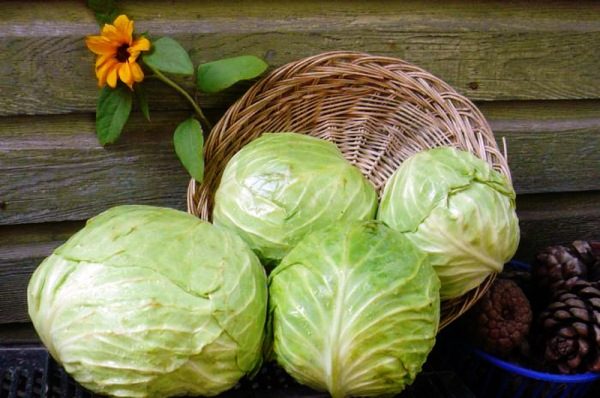
But besides the positive qualities of the variety, it is also endowed with disadvantages:
- demanding of soilgrows best on loam and peat;
- badly tolerates frequent soil moisture;
- sunning;
- needs big amount of moisture at the stage of formation of the plug;
- at temperatures above 30 ° C plugs "leaves" in the leaves;
- during the whole growing season Valentine's variety needs watering and making feeding;
- long harvest time.
Sowing seeds for seedlings
Forks of later varieties are always grown through seedlings. But before embarking on planting, it is necessary to choose the right seeds. If they are purchased in the store, from trusted suppliers, such seeds do not need preliminary preparation, which includes the following steps:
- hardening;
- disinfection;
- warming up;
- soak.
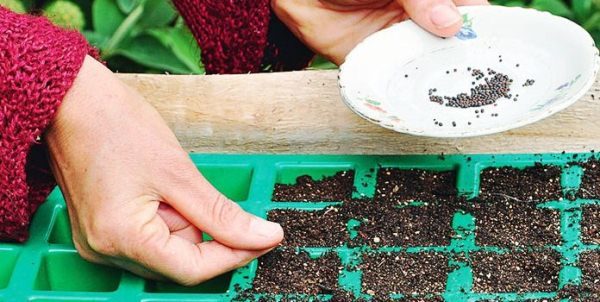
Most often, the shelf life of seeds is 3-4 years, during which the crop will retain all the varietal qualities of the hybrid.
The time of sowing seed on seedlings directly depends on the expected time of its disembarkation. Given that it is planted in the ground in early June, the optimal time for sowing seeds is 6 May, however, this can be done in April.
The deadline for sowing seeds for cultivation is May 21, which is St. Nicholas Day.
After the seeds are selected, you need to prepare the ground for their sowing.For these purposes, a loose and nutritious earthen substrate is needed, the acidity index of which does not exceed 6 pH. You can buy ready-made earthen mixture in a specialty store or prepare the substrate yourself:
- Mix equal parts humus and earth and 5-6 kg of the mixture you need to add a glass of sand.
- To mix 1 piece of sod land 3 parts of peat and for every 3-4 kg of the mixture pour 1.5 cups of sand.
After the earthen substrate is ready for sowing, it is worthwhile to evenly distribute the seeds over the surface of the moistened soil. On top of the seeds it is necessary to pour a layer of the prepared substrate 1 cm thick, and then carefully pour it with a spray bottle.
The container with the sown seeds is covered and placed in a dark but warm place, with an air temperature of 15 ° C. At the same time, one should not forget to control the emergence of shoots that hatch later. 3-7 days When the first shoots appear, it is worth taking out the container with seedlings to a bright place so that the plants do not stretch out.
Pick up saplings and planting seedlings in the ground
After 2 true leaves appear on the seedlings, the seedling should be dived.So called transplanting seedlings in a separate container and pinching the roots, which allows to enhance the growth of the plant.
To do this, it is recommended to perform the following actions:
- Plentifully water the seedlings, wait until moisture is absorbed, and then carefully pull out the seedling along with a lump of earth stuck to the roots.
- Trim about a third of the root system.
- Put the roots in the groove in the ground to the cotyledon leaves, and then cover them with earth.
- The composition of the earth mixture should be the same as used for sowing seedlings.
When the plants have a third pair of leaflets, the cabbage seedlings, which have reached a height of 13-16 cm, can be planted on the garden bed. But before doing this, you must first prepare the ground for planting. Cabbage Valentine F1 prefers loamy soil in which moisture is well preserved. The bed with plants should be well lit by the sun, as this variety does not tolerate excessive shading.
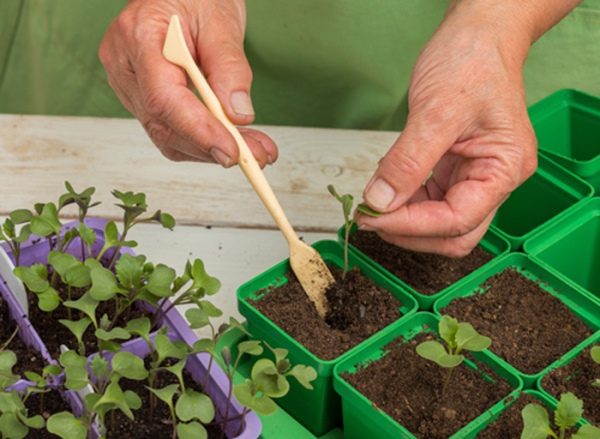
It is best to prepare a place for planting seedlings right from the fall, while respecting the crop rotation. Cabbage grows best after onions, cucumbers, carrots, tomatoes, legumes and cereals, which enrich the soil with nutrients necessary for cruciferous plants. If you plant a Valentine F1 hybrid after your “relatives” (swede, radish and radish), it will grow poorly and bear fruit, since there will not be enough trace elements in the earth.
Autumn preparatory work for planting seedlings are as follows:
- We dig up the bed to the maximum depth.
- We fertilize the landFor what the compost is put in the fall, at the rate of 1 bucket per 1 meter of bed.
- Spring to land further is brought 2 spoons of superphosphate on 1 square meter of the area, and also a glass of pure ashes.
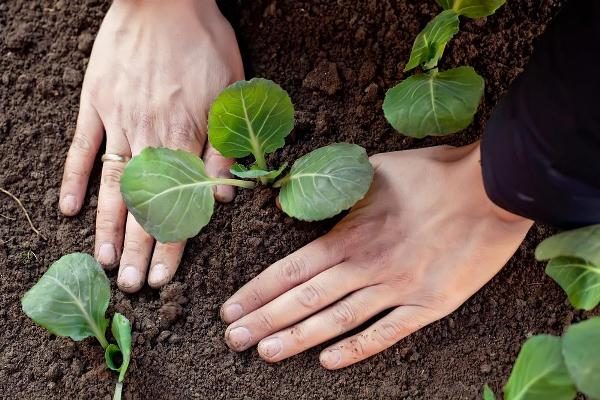
Planting a Valentine F1 variety in a permanent place, it follows that at night the air temperature does not fall below 3 ° C. It is better to do work in the evening, after sunset, or to choose a cloudy day for planting cabbage.
The scheme of disembarkation of seedlings of Valentine F1 - 65-70 see between rows and 40 see between plants. With a thicker planting, cabbages can develop poorly and lose their weight. After transplanting, it is important to water each plant abundantly.
Cabbage care
In order to get a good harvest from Valentina, you should make some efforts. These include watering, loosening, weeding, hilling and feeding.
After planting seedlings daily watering is a must. Also, a high need for abundant moisture occurs in the period of tying and growth of heads. If at this time there will be a shortage of water, then the whole cabbage can go to the leaves. Also, the lack of moisture can lead to ripening of loose and not juicy heads.
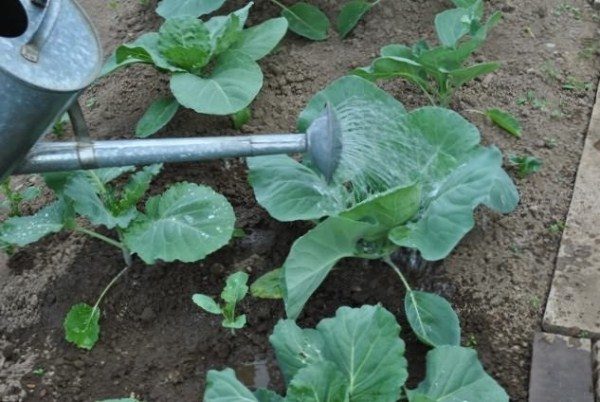
Watering the plugs formed is best early in the morning or late in the evening, and the water consumption should be about 5 liters per plant. After the water is completely absorbed, it is necessary to pierce the earth to a depth of 6 cm, since excess water for the Valentine F1 variety is destructive - its roots quickly rot and the plant dies.
Completely stop watering is 3-4 weeks before harvest. During this period, the cabbages will have time to acquire sugar content, retain their product form and will be stored better.
An important role is played by the destruction of weeds, because they quickly deprive the plugs of sunlight and are often the source of various diseases. Loosening the soil will help to cope with weeds, which will only benefit cabbage.
Another measure of care is hilling, which helps the stalk to hold a good head of cabbage well. Hilling is done about 2 times per season:
- First time hilling done later 7-10 days after disembarkation seedlings to a permanent place when it is well acclimatized.
- The second hilling is performed later. 1-1,5 of the monthwhen the heading begins to form. With the help of hilling, it is possible to protect the head from excessive moisture and prevent the plant from rolling over on its side in strong winds.
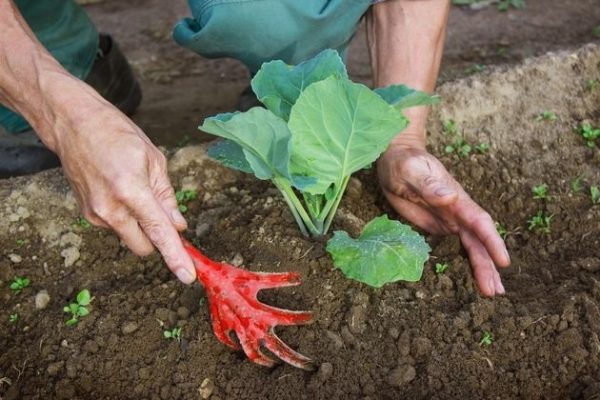
Hilling Depth - no more than 6 cm, the diameter of the scooping of the ground is about 1 plant - 30 cm. It is best to do hilling after heavy rain or heavy irrigation.
Additional feeding is carried out 4 times during the growing season. They need nitrogen, phosphorus, calcium and potassium to form well-headed cabbages. Since all these elements are present in cow dung, it is possible to alternate the application of mineral and organic fertilizers under the cabbage.
Harvesting and Storage
You can start harvesting in late September or early October. Keep cabbages best in the basement, at a temperature not lower +1 C ° and no higher +5 C °. Otherwise, the cabbage can either freeze or start to rot.
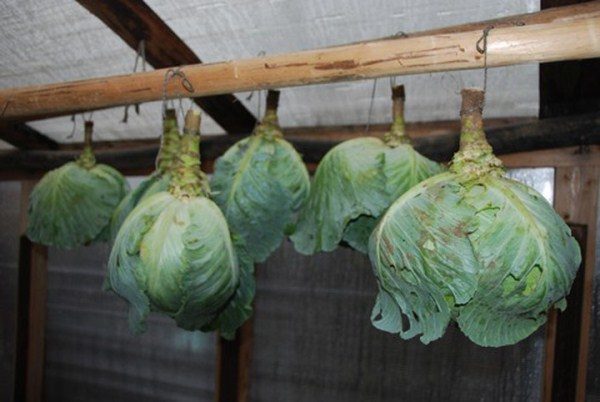
Main storage methods:
- on the rack;
- in limbo;
- in boxes.
Some housewives each head out wrapped in paper or cling film that will preserve the juiciness of the forks. Before storing it, you should carefully check all cabbages and select discarded ones. Also, all surface leaves are removed from each of them, leaving 2-3 of them on each fork.
Valentina F1 variety is stored for 7 months and due to the good taste and beneficial properties of the head of the head, this hybrid is attractive for cultivation in both industrial and private farms.
